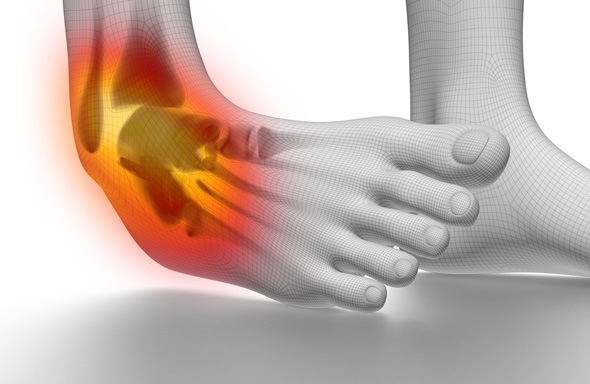
What is Nociceptive Pain?
Nociceptive pain is a type of pain that involves the detection of noxious stimuli by nociceptors, which is carried through the central nervous system for the body to respond and protect itself from harm.
Nociceptors exist in many areas throughout the body, including both somatic and visceral tissues. Examples of nociceptive pain include pain from a burn, bruise, infection or bone or muscular injury, all of which are usually temporary but may continue for an extended period of time in some cases.

Copyright: CLIPAREA l Custom media, Image ID: 227120620 via Shutterstock
Characteristics of Nociceptive Pain
Nociceptive pain typically responds well to analgesic and anti-inflammatory medications and can usually be well controlled with pain relief management techniques.
Nociceptive pain can be acute or chronic, depending on the conditions that caused the incident, although temporary cases are more common. A muscular injury, such as a sprained ankle, is an example of acute nociceptive pain, whereas pain from cancer or arthritis may be chronic.
Mechanism of Nociceptive Pain
The nociceptors in the body play a key role in the transduction phase of nociception and are responsible for the detection of noxious mechanical, thermal or chemical stimuli.
There are two main types of nociceptors, known as C-fibers and A-delta fibers. C-fibers are unmyelinated and are associated with dull, general pain, whereas A-delta fibers are myelinated and associated with sharp, localized pain. Both types of fibers are depolarized by voltage-gated ion channels in response to stimuli to reach an action potential.
Under normal circumstances, nociceptors have a high activation threshold and require significant stimulation to generate an action potential. However, injury to the tissue of neurons or exposure to certain substances such as bradykinin, serotonin, histamine, prostaglandins and hydrogen ions can increase the sensitivity of the nociceptors, which is known as hyperesthesia.
Following the generation of the action potential in the nociceptors, the electrical signals are conducted across the peripheral nerves to the central nervous system. Depolarization of the presynaptic terminal is a critical step, which leads to the continuation of the electrical signals into the dorsal horn.
Within the dorsal horn, large, fast and myelinated A-beta fibers carry the electrical signals from the mechanoreceptors and modulate the nervous activity. The final perception of nociceptive pain occurs as a result of several pathways in the spinal cord and regions in the brain.
Types: Somatic and Visceral Pain
There are two types of nociceptive pain, known as somatic and visceral pain, which are distinct in nature and the origin of the noxious stimuli
Somatic nociceptive pain originates from nociceptors in the skin, bones, connective tissue, muscles or joints. This type of pain is usually sharp and well localized in the initial stages, although may progress into a dull ache with time, particularly for deep somatic pain in the muscles and bones.
Visceral nociceptive pain originates from nociceptors in or near the internal organs. This is usually described as a dull, aching pain in a general area and example of this type of pain include abdominal or thorax pain.
Management of Nociceptive Pain
Both somatic and visceral nociceptive pain typically respond well to analgesic medications, such as paracetamol, ibuprofen and aspirin. They can be managed effectively with standard pain relief techniques and, unlike neuropathic pain, do not respond well to neurostimulation.
References
- http://www.rnceus.com/ages/nociceptive.htm
- http://www.medscape.org/viewarticle/489495_4
- http://www.ajmc.com/journals/supplement/2006/2006-06-vol12-n9suppl/jun06-2326ps256-s262/
- http://www.helpforpain.com/arch2000dec.htm
Further Reading
Last Updated: Aug 23, 2018






















.png)










No hay comentarios:
Publicar un comentario